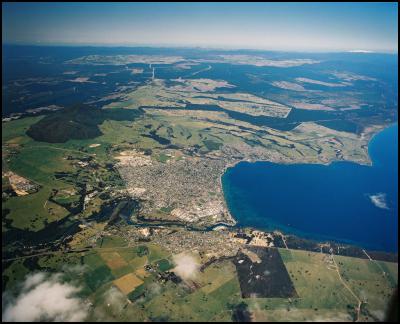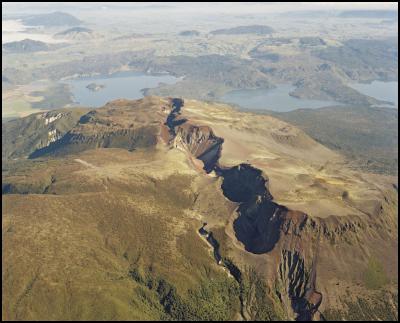Taupo hosts international conference on volcanoes
4 December 2014
Taupo hosts international conference on volcanoes
Volcanoes in the central North Island will get star billing when volcanologists from all over the world gather in Taupo this weekend for a week-long conference on calderas (large collapsed volcanoes).
The 5th Workshop on Collapse Calderas will be attended by about 80 scientists from a dozen countries. The event is hosted by GNS Science and the University of Canterbury.
Like previous meetings in the series, the workshop will be devoted to understanding many different aspects of caldera volcanoes. The event is generally held every two years in unique venues around the world.
This time it is New Zealand’s chance to showcase its large volcanoes to an international scientific audience. There are eight caldera volcanoes in the Taupo Volcanic Zone, which extends from coastal Bay of Plenty to Lake Taupo, and they are widely recognised as some of the best examples of this type of volcano in the world*.
Workshop co-conveners Prof Jim Cole from Canterbury University and Nico Fournier of GNS Science are especially proud to be leading this event. “This is the first time since 1986 that we have hosted an international volcanological meeting with a focus on caldera volcanoes,” said Professor Cole.
“The 1986 meeting was based on the centenary of the 1886 Tarawera Rift eruption, our most recent eruption from a caldera in New Zealand.”
Workshop sessions will include the physical setting of calderas, their eruption histories, and the processes occurring in magma systems that feed these.
Another focus will be the natural resources related to calderas such as geothermal systems and the formation of minerals.
Of special interest locally is how scientists monitor these large volcanoes for signs of unrest, even if it rarely leads to eruptions.
The workshop will provide the opportunity to local scientists, emergency managers and local government representatives to discuss the issues and listen to international scientists present their latest research findings.
Included are two one-day field trips, where participants will get to see aspects of Taupo, Rotorua, Reporoa and Okataina calderas.
The workshop is sponsored by GNS Science, the University of Canterbury and the International Association of Volcanology and Chemistry of the Earth’s Interior Commission on Collapse Calderas (CCC). The CCC was formed in 2008 with the aim of gaining a wider and deeper understanding of caldera volcanoes.
It promotes interdisciplinary interaction to help solve the many questions regarding the formation of collapse calderas, their evolution, and their potential impacts on society.
Events in this series have been held at Tenerife, Canarias (2005), Mexican Volcanic Belt (2008), Reunion Island (2010) and Bolsena, Italy (2012). It is now New Zealand’s turn to host one.
Adam Munro, the chairman of the Caldera Advisory Group, which coordinates activities between agencies such as district and regional councils, Civil Defence and GNS Science, said; “This will be a unique opportunity to provide our emergency managers and communities with an overview of the large scale volcano problems in the area.”
Caldera volcanoes are usually formed by the collapse of land following a large volcanic eruption in which the magma chamber empties largely or completely. This class of volcano is the source of some of the largest eruptions on Earth.
*Volcanologists describe the Taupo Volcanic Zone as the biggest factory of rhyolitic magma in the world. Its caldera volcanoes (eg Taupo) have produced some of the biggest eruptions recorded anywhere in the past tens of thousands of years. From these two perspectives, the TVZ and New Zealand’s calderas are unique.

Click for big version.
Taupo township sits at the northern end of the Taupo caldera, which has produced two of the world's most powerful eruptions in the past 5000 years. The Taupo volcano has erupted 26 times in the past 26,000 years. Its most recent eruption was 1800 years ago. Photo: Lloyd Homer, GNS Science

Click for big version.
The eruption of Mt Tarawera in 1886 was most New Zealand's most recent caldera eruption. This photo shows the long fissure, or rift, that opened up during the eruption. The eruption destroyed the famous Pink & White Terraces. However, scientists found remnants of the Terraces at the bottom of Lake Rotomahana in 2011. Photo: Lloyd Homer, GNS Science
ENDS


 Business Canterbury: Urges Council To Cut Costs, Not Ambition For City
Business Canterbury: Urges Council To Cut Costs, Not Ambition For City Wellington Airport: On Track For Net Zero Emissions By 2028
Wellington Airport: On Track For Net Zero Emissions By 2028 Landcare Research: ANZAC Gall Fly Release Promises Natural Solution To Weed Threat
Landcare Research: ANZAC Gall Fly Release Promises Natural Solution To Weed Threat NZ Anti-Vivisection Society: Auckland Rat Lovers Unite!
NZ Anti-Vivisection Society: Auckland Rat Lovers Unite! University of Canterbury: $1.35 Million Grant To Study Lion-like Jumping Spiders
University of Canterbury: $1.35 Million Grant To Study Lion-like Jumping Spiders Federated Farmers: Government Ends War On Farming
Federated Farmers: Government Ends War On Farming



